As we all know that nutrition is a very important topic in class 10th biology section. Nutrition is like a fuel and building blocks that our body needs to stay healthy and function properly. Or Imagine nutrition is a toolbox our bodies use to repair, grow, and maintain themselves – it’s like giving our cells the right tools to keep the whole system running smoothly. The process of nutrition encompasses the intake of various essential nutrients such as carbohydrates, proteins, fats, vitamins, and minerals that the body needs for proper functioning and maintenance. Nutrition is of two types: Autotrophic nutrition and Heterotrophic nutrition. Here we will discuss briefly the heterotrophic mode of nutrition.
What is Heterotrophic Nutrition?
Heterotrophic nutrition is a mode of nutrition obtaining energy and nutrients by consuming organic matter produced by other organisms. Unlike autotrophic nutrition, in which organisms can create their own food through processes like photosynthesis and chemosynthesis. Heterotrophs rely on external sources of nutrition, such as plants, animals, or decomposed matter. They break down complex organic molecules into simpler ones, like glucose, which they can then use as a source of energy to carry out their life processes. Heterotrophic nutrition is of three types: Holozoic nutrition, Saprophytic nutrition, and Parasitic nutrition.
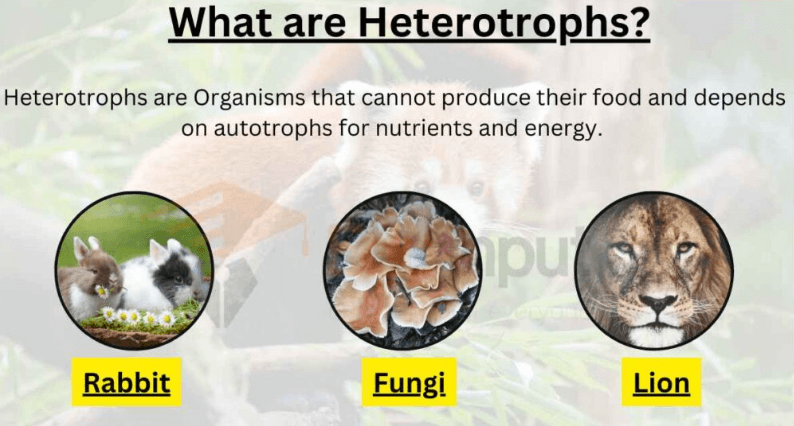
Heterotrophic Nutrition Types
There are mainly three types of heterotrophic nutrition which are named Holozoic nutrition, Saprophytic nutrition, and Parasitic nutrition. These different types of heterotrophic nutrition reflect the diverse strategies that organisms have evolved to obtain energy and nutrients from their environment.
| Heterotrophic Nutrition Types | |
| Types | Description |
| Holozoic Nutrition | In this type of nutrition, organisms ingest solid organic material and digest it internally. Almost all animals including humans, exhibit holozoic nutrition. |
| Saprophytic Nutrition | In this, the organisms obtain nutrients by externally digesting dead and decaying organic matter using enzymes. Fungi and certain bacteria follow saprophytic nutrition. |
| Parasitic Nutrition | The parasites derive nutrients from a living host organism, often causing harm to the host. Examples include ticks, tapeworms, and lice. |
1. Holozoic Nutrition
Holozoic nutrition is a mode of feeding observed in various animal species, where they ingest solid food and then break it down internally through various digestive processes to extract nutrients. This nutritional strategy allows animals to obtain complex organic molecules that they cannot synthesize themselves. In the process of holozoic nutrition, animals use specialized structures such as the mouth, jaws, teeth, and digestive system to capture, ingest, and process food.
The process typically involves several stages: Ingestion, Digestion, Absorption, Assimilation, and Egestion. Holozoic nutrition is a remarkable adaptation that has enabled a vast array of animal species to thrive in diverse environments. It takes place in almost all living organisms including animals, humans, and some unicellular organisms such as amoeba, and paramecium. From herbivores to carnivores, and omnivores, holozoic nutrition strategies vary greatly.
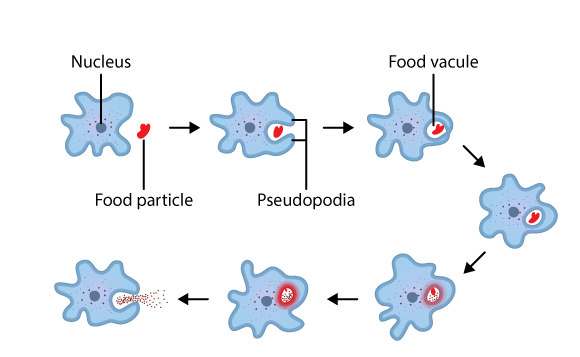
Types of Holozoic Organisms
Holozoic organisms can be categorized into different types based on their feeding habits and preferences. These different types of holozoic organisms demonstrate the incredible diversity of feeding strategies. Each type has developed specialized traits that allow them to thrive in their respective ecological niches and obtain the nutrients necessary for survival.
- Herbivores: Herbivores are holozoic organisms that primarily consume plant material. They have specialized adaptations such as flat teeth for grinding and processing plant fibers. Examples include cows, horses, and rabbits.
- Carnivores: Carnivores are holozoic organisms that primarily consume other animals. They have adaptations such as sharp teeth and claws for capturing and consuming prey. Examples include lions, tigers, and eagles.
- Omnivores: Omnivores are holozoic organisms that have a mixed diet, consuming both plant material and other animals. They possess a combination of teeth suited for both grinding and tearing. Examples include humans, bears, and pigs.
2. Saprophytic Nutrition
Saprophytic Nutrition is a type of heterotrophic nutrition in which organisms obtain their nourishment by feeding on dead and decaying organic matter. These organisms known as saprophytes, break down dead plants, animals, and other organic material, absorbing nutrients and energy from the decomposed matter. This process helps recycle nutrients and contributes to the decomposition of organic material in the ecosystem. Some examples of saprophytes are Bacteria, Mushrooms, and Mold.
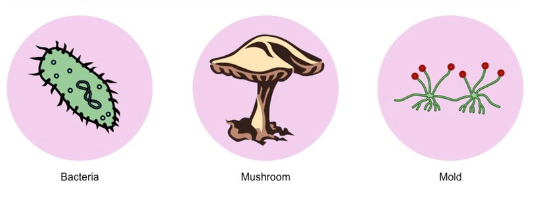
The process of saprophytic nutrition involves several steps.
- First, saprophytic organisms, such as fungi and some bacteria, secrete enzymes onto the decaying organic matter.
- These enzymes break down complex organic molecules like proteins, carbohydrates, and fats into simpler compounds.
- Once, the organic matter is broken down, the saprophytes absorb the resulting nutrients and small molecules through their cell walls or membranes.
- These nutrients are then transported into their cells and used for energy production, growth, and reproduction.
- Throughout this process, the saprophytic organisms play a crucial role in the decomposition of dead organic material, helping to recycle nutrients back into the ecosystem.
Types of Saprophytic Organisms
Saprophytic organisms encompass a variety of species, mainly fungi and certain types of bacteria. These organisms collectively play a vital role in nutrient cycling and ecosystem health by breaking down dead organic material.
- Saprophytic Fungi: Fungie are perhaps the most well-known saprophytic organisms. Examples include molds, yeasts, and mushrooms. They secrete enzymes that break down organic matter, and their mycelium (thread-like structures) then absorb the resulting nutrients.
- Saprophytic Bacteria: Certain bacteria are also saprophytic. They secrete enzymes that break down organic compounds in their environment, and then they absorb the breakdown products. Examples include some species of Clostridium and Bacillus.
- Actinomycetes: These are filamentous bacteria that resemble fungi in their growth pattern. They play a significant role in decomposing tough plant materials like cellulose and Lignin.
3. Parasitic Nutrition
The parasitic nutrient is a type of feeding strategy in which an organism, known as a parasite, obtains nutrients from another living organism, known as the host. The parasite relies on the host for various nutrients, such as food molecules and energy, without providing any benefit to the host. This relationship can be harmful to the host, potentially leading to weakened health or even death.
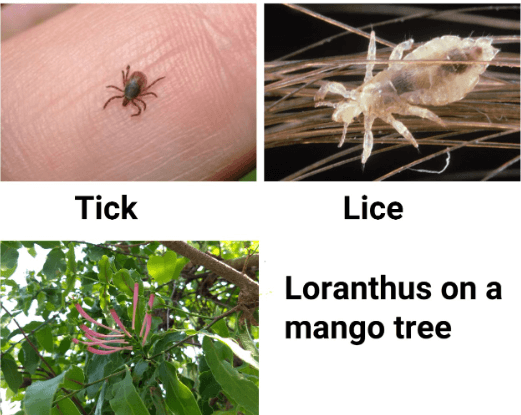
Parasites often have specialized adaptations to attach themselves to or live within the host, allowing them to extract nutrients and reproduce. The process of parasitic nutrition has several steps: attachment, penetration, feeding, nutrient absorption, avoiding host defenses, reproduction, and lastly detachment and transmission.
Types of Parasitic Organisms
There are several types of parasitic organisms that exhibit different strategies and adaptations for obtaining nutrients from their hosts. Each type of parasite has its own set of adaptations suited to its particular host and environment.
- Ectoparasites: These parasites live on the surface of the host’s body. Examples include ticks, lice, fleas, and mites. They attach to the host’s skin or feathers and feed on blood, skin cells, or other bodily fluids.
- Endoparasites: These parasites live inside the host’s body. They can be further categorized based on where they reside within the host:
(a) Intestinal Parasites: These parasites live within the host’s digestive tract. Examples include tapeworms, roundworms, and flukes. They absorb nutrients from the host’s digestive system.
(b) Intracellular Parasites: These parasites live inside the host’s cells. Examples include various types of bacteria, protozoa, and viruses. They often manipulate the host cell’s functions to their advantage.
- Zombie Parasites: These parasites manipulate their host’s behavior to increase their own chances of reproduction or transmission. For instance, the parasite Toxoplasma gondii (a parasitic protozoan that causes toxoplasmosis) can alter the behavior of rodents to make them more likely to be eaten by cats, which are the parasite’s definitive host.
Functions of Heterotrophic Nutrition
Heterotrophic nutrition refers to obtaining nutrients from organic sources, unlike autotrophic nutrition where organisms make their own food through photosynthesis or chemosynthesis. Here we have mentioned some important functions of heterotrophic nutrition:
- Energy Acquisition: Heterotrophic organisms obtain energy by breaking down complex organic molecules into simpler ones, releasing energy in the process.
- Metabolism: The nutrients obtained through heterotrophic nutrition serve as substrates for various metabolic pathways, including glycolysis, the citric acid cycle, and cellular respiration.
- Repair and Maintenance: Heterotrophic nutrition provides the building blocks necessary for repairing damaged tissues and maintaining cellular structures.
- Predation and Defense: Some heterotrophs hunt or consume other organisms, functioning as predators which helps in the proper functioning of the Food chain, while others may use heterotrophic nutrition to defend against pathogens or parasites.
- Ecological Niches: Different types of heterotrophic nutrition (herbivory, carnivory, and omnivory) enable organisms to occupy distinct ecological niches, reducing competition within ecosystems.

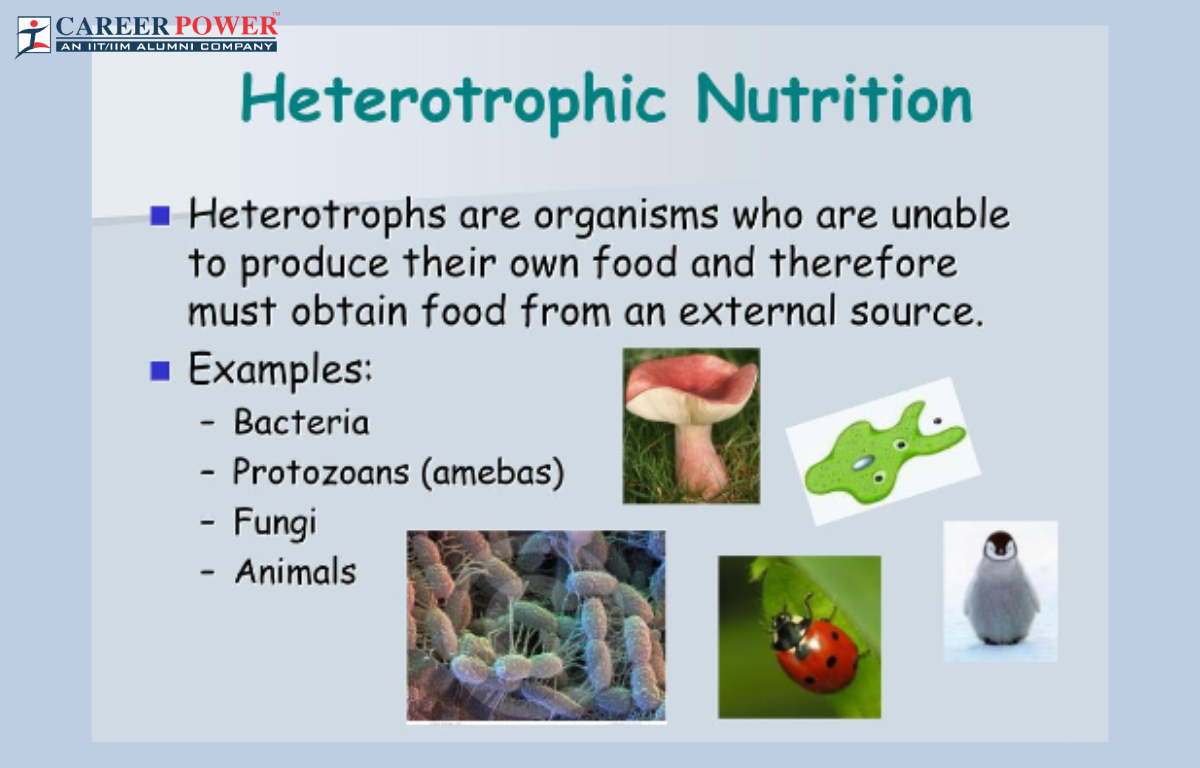
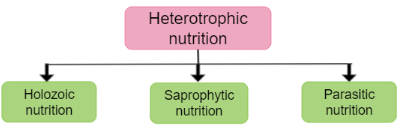

 50 Vegetables Name for Kids in English a...
50 Vegetables Name for Kids in English a...
 Food Chain: Definition, Types, Examples,...
Food Chain: Definition, Types, Examples,...
 Human Respiratory System: Definition, Di...
Human Respiratory System: Definition, Di...













